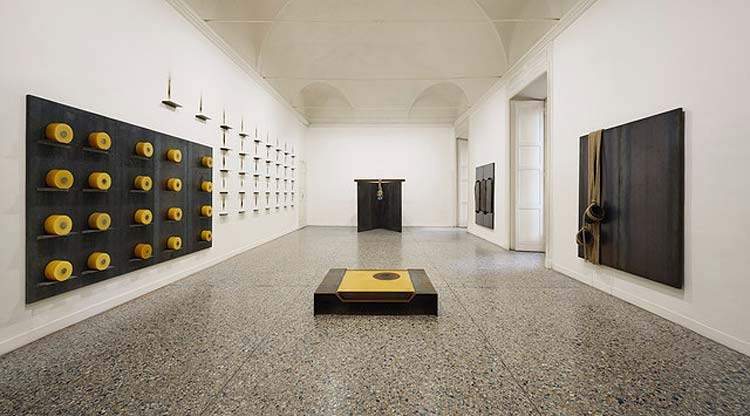Milan, the historic gallery with which Jannis Kounellis collaborated dedicates an exhibition to him
From Oct. 12, 2022, to Jan. 21, 2023, Milan ’s Christian Stein Gallery presents the Kounellis exhibition at its headquarters in Corso Monforte 23, which pays tribute to the naturalized Italian-born Greek artist Jannis Kounellis (Piraeus, 1936 - Rome, 2017) through a selection of seven works that when set up together make up a single unprecedented choral installation with environmental dimensions within the exhibition hall. The event, organized by the historic gallery with which Kounellis collaborated for a long time, opens a glimpse into the imagination of the artist considered one of the main exponents of the Arte Povera movement by highlighting innovative elements and legacies of his artistic practice.
Since the 1960s, Jannis Kounellis has been deconstructing and reformulating the language of painting, preferring to the traditional means of painting a mixture of mediums (performance, sculpture, installation) and unusual materials within the exhibition space. Today, metal plates, charcoal, the smoke trace on the wall, jute canvas, bell, and coat return to the exhibition, accompanied by less usual elements in the artist’s production such as the crucible and wax. Of these, even the smells can be felt in the room, constituting a vocabulary of latent images awakening memories linked to our individual and collective experience. The viewer is thus obliged to share the “performance space” with the work, which, projected beyond the canvas, invades the environment. The 1987 work, set up on the widest wall of the gallery, consists of two rectangular modules: a double iron plate to which twenty yellow wax cylinders are attached and a group of empty shelves, holding the soot marks imprinted on the wall. On the ground, she is echoed by another work from the same year: a later version of the iron “charcoal kiln” first made in 1967, whose metal structure this time is filled with yellow wax and tar.
The 1993 work, displayed at the back of the room, features a bell and two iron plates arranged at an angle and topped by a girdle. The bell hangs from the rope while the putrella supports its actual weight. The bell half-painted black is symbolic of a ritual that has defined the sense of community for centuries. Leaving the wall, the work inhabits the same space as the viewer, defining itself in relation to the viewer’s physical experience. On the opposite side of the room are two large slabs, one surrounded by a bundle of ropes holding two crucibles (1990), the other composed of three black coats pressed by as many metal plates (2009). Also on display are two smaller plates whose shelves hold coal (1988) and jute sacks (2000), respectively.
For Rudi Fuchs, an art historian who has been the director of the Van Abbemuseum in Eindhoven, the Stedelijk Museum in Amsterdam and the Museum of Contemporary Art at the Castello di Rivoli, as well as a close friend of Kounellis, with whom he appears pictured in the photo of theinvitation to the exhibition, “A work by Kounellis is always surprising and unexpected, it is not the result of a style but of historical confrontation, of a sudden intervention in the seemingly balanced and flexible course of history.” Jannis Kounellis first exhibited at the Christian Stein Gallery in 1967 in the group exhibition Confrontations. Since that time the gallery and artist have continued to collaborate, organizing more than twenty-five exhibitions together. The gallery is still actively engaged in the appreciation and circulation of his work around the world.
 |
| Milan, the historic gallery with which Jannis Kounellis collaborated dedicates an exhibition to him |
Warning: the translation into English of the original Italian article was created using automatic tools. We undertake to review all articles, but we do not guarantee the total absence of inaccuracies in the translation due to the program. You can find the original by clicking on the ITA button. If you find any mistake,please contact us.




























